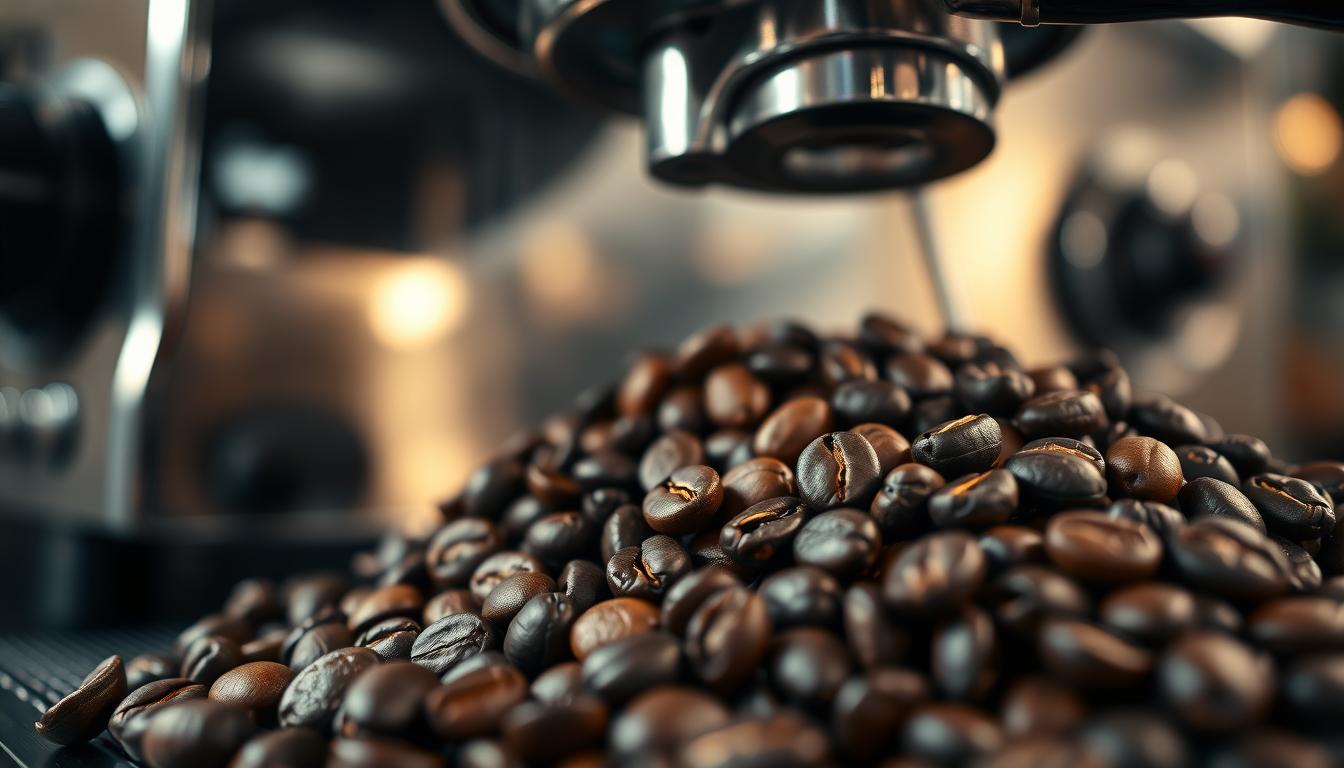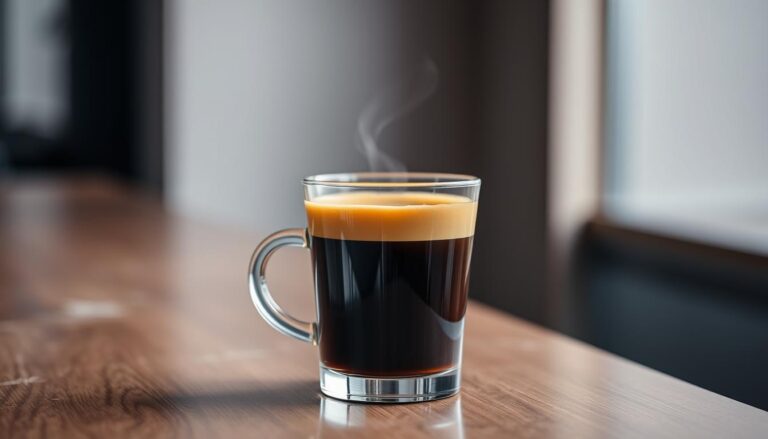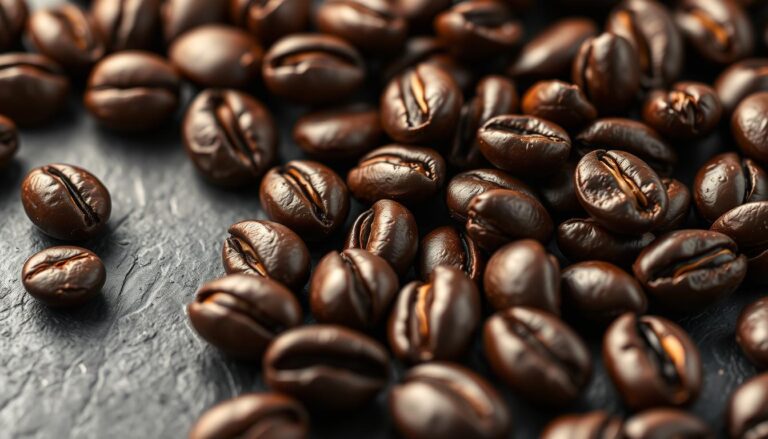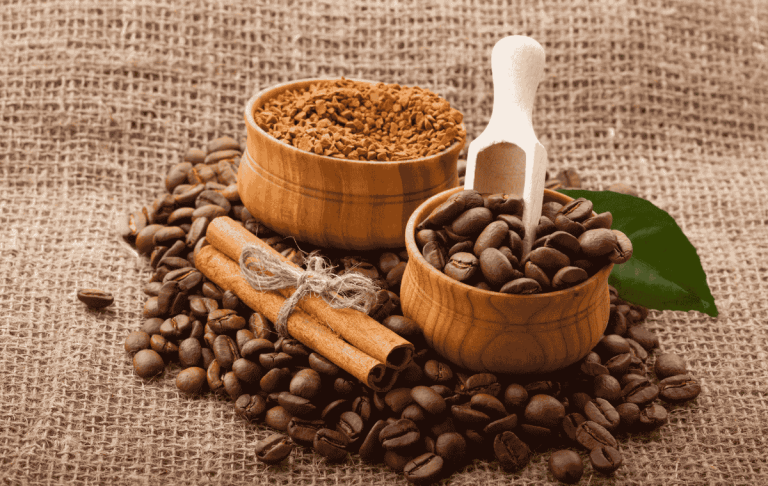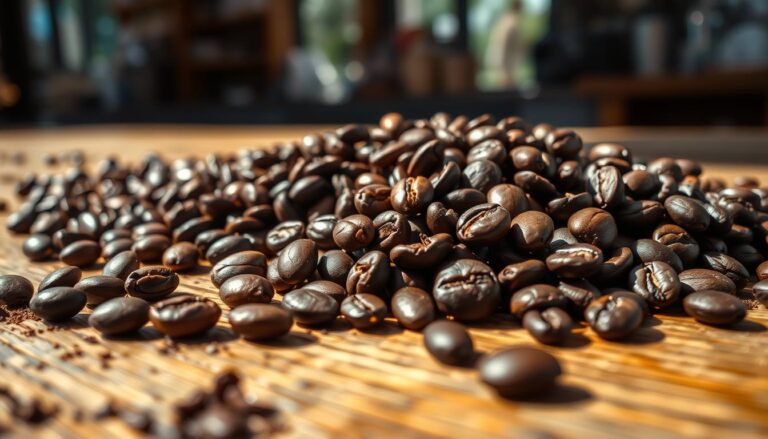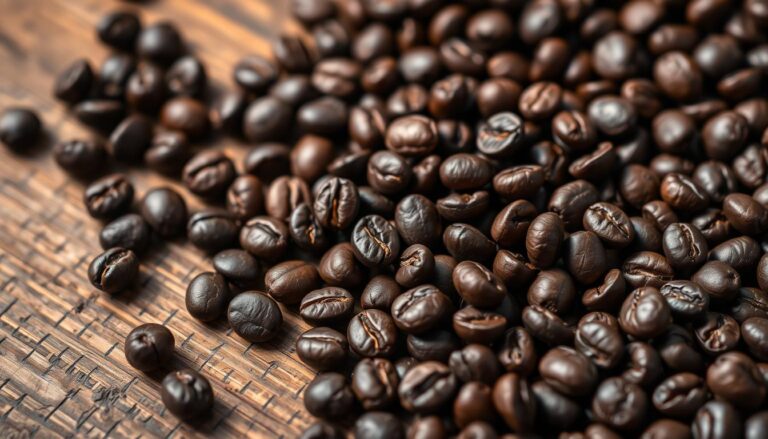Ever thought about what coffee to use in an espresso machine for the perfect shot? There are many options, and picking the right one can change your latte or cappuccino game. You’ll learn about key factors like the type of beans, grind size, and roast levels. Knowing these will improve your espresso’s quality and make choosing coffee easier.
Espresso Coffee Types
Choosing the right coffee for your espresso machine can really change your experience. Knowing about the different types of coffee for espresso machines can make your espresso better. Let’s take a look at some popular coffee varieties.
Arabica vs. Robusta
Arabica and Robusta are the main types of coffee beans. Arabica beans have a sweet, complex taste. They offer bright fruit notes and balanced acidity, perfect for those who want to get the most flavor from their espresso.
Robusta beans, on the other hand, are stronger with a more bitter taste. They have more caffeine, making them great for espresso blends that need extra body and crema.
Single-Origin vs. Blend
When picking coffee for your espresso machine, you’ll find single-origin and blended coffees. Single-origin coffees come from one place, showing off unique flavors from that area. Blends mix beans from different places to create a certain taste.
This mix can make your espresso more complex, giving you a wide range of tastes in your cup.
Flavor Profiles
The flavors of espresso machine coffee can be very different. You might find nutty and chocolatey, fruity and floral, and more. Think about what you like best when choosing your coffee.
Knowing your taste preferences will help you pick the right espresso machine coffee blends to try.
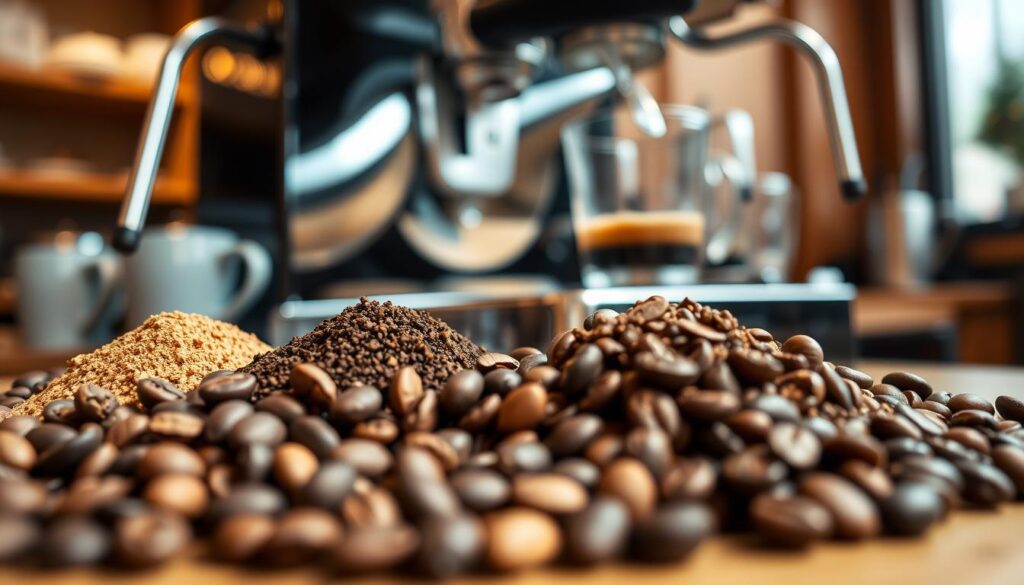
| Coffee Type | Flavor Notes | Caffeine Content | Best Use |
|---|---|---|---|
| Arabica | Sweet, Fruity, Balanced | Low | Espresso |
| Robusta | Strong, Bitter, Earthy | High | Blends for Body |
| Single-Origin | Varies by Region | Varies | Specialty Espresso |
| Blend | Complexity of Combined Flavors | Varies | General Espresso Use |
The Importance of Coffee Grind Size
Choosing the right grind size is key to great espresso. The grind size affects how well the coffee is extracted, which changes the flavor. Knowing the difference between coarse and fine grinds can make your coffee better and ensure you get the best espresso.
Coarse vs. Fine Grind
A fine grind is needed for espresso to get the right pressure for extraction. If the grind is too coarse, the coffee can be weak and bitter. On the other hand, a fine grind can make the coffee rich and creamy. Finding the right balance is important.
Finding the Right Consistency
It might take some trial and error to find the perfect grind for you. Things like the coffee beans, your espresso machine, and what you like all matter. Getting the grind right helps get the best out of your espresso machine.

Roast Levels and Their Impact on Espresso
Choosing the right roast level is key when picking coffee for espresso machines. The roast level affects the flavor and how the coffee extracts. Each roast level brings unique qualities that can improve your espresso.
You have three main roast categories: light, medium, and dark. Each offers different flavors that can change your espresso experience.
Light Roast Considerations
Light roasts have high acidity and bright, fruity notes. They are interesting for espresso. At a higher water-to-coffee ratio, like in a lungo shot, these flavors shine.
But, light roasts might not be the best for milk-based drinks. Their delicate flavors could get lost, making your espresso less enjoyable.
Medium Roast Characteristics
Medium roasts balance acidity and sweetness, giving a smooth flavor. They keep some fruity notes and add caramel and nutty undertones. This makes them good for many espresso types.
They work well with milk, improving lattes and cappuccinos. Choosing a medium roast can open up more options for your espresso machine.
Dark Roast Preferences
Dark roasts have a bold, rich taste with less acidity. Their flavors are deep and chocolatey, perfect for those who like strong espresso. The oils in dark roasts create a luxurious crema.
Dark roasts are great if you often drink your espresso without milk. They keep their diverse and strong flavors even when enjoyed black.
Best Coffee Beans for Espresso Machines
Choosing the right coffee for your espresso machine is key. It’s about finding beans that taste great and work well with your machine. Knowing the best brands and certifications helps you pick the perfect espresso beans.
Popular Brands to Consider
Many brands are known for their high-quality espresso beans. Here are a few:
- Intelligentsia Black Cat Classic: It’s sweet and balanced, great for all kinds of espresso.
- Stumptown Hair Bender: This blend is rich and vibrant, with a cocoa-like taste.
- Counter Culture Big Trouble: It’s smooth and nutty, perfect for easy-to-drink espresso.
Certifications to Look For
Look for certifications when picking espresso beans. They show the beans are of high quality and ethically sourced:
| Certification | Meaning |
|---|---|
| Fair Trade | Guarantees farmers get fair prices and support sustainable farming. |
| Organic | Means the beans were grown without harmful chemicals. |
| Rainforest Alliance | Supports environmental protection and fair worker conditions. |
| Specialty Coffee Association (SCA) | Shows the beans are of the highest quality, meeting strict standards. |
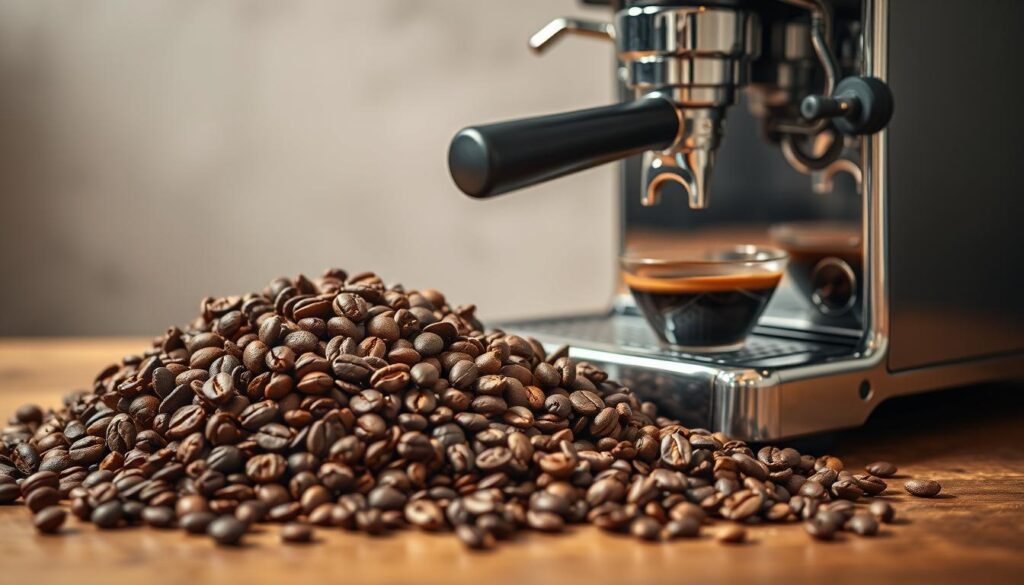
The Role of Freshness in Coffee Choice
Freshness is key to the quality of your espresso. When picking espresso machine coffee, the freshness of your beans matters a lot. Fresh beans release gases that help create rich crema and taste. It’s best to use beans roasted recently.
Why Freshness Matters
Espresso beans are at their best 7 to 21 days after roasting. This time lets them degas, releasing carbon dioxide. This is important for the crema and taste of your espresso. As beans get older, they lose CO2 and dry out, affecting crema and taste.
Tips for Storing Coffee Beans
Storing beans right keeps them fresh. Here are tips to keep your espresso machine coffee fresh:
- Use an airtight container: This keeps air out and beans in.
- Keep it cool: Store beans in a cool spot, away from light and moisture.
- Buy in small batches: Get only what you need to avoid aging.
- Avoid the fridge: The changing temperatures can add moisture.
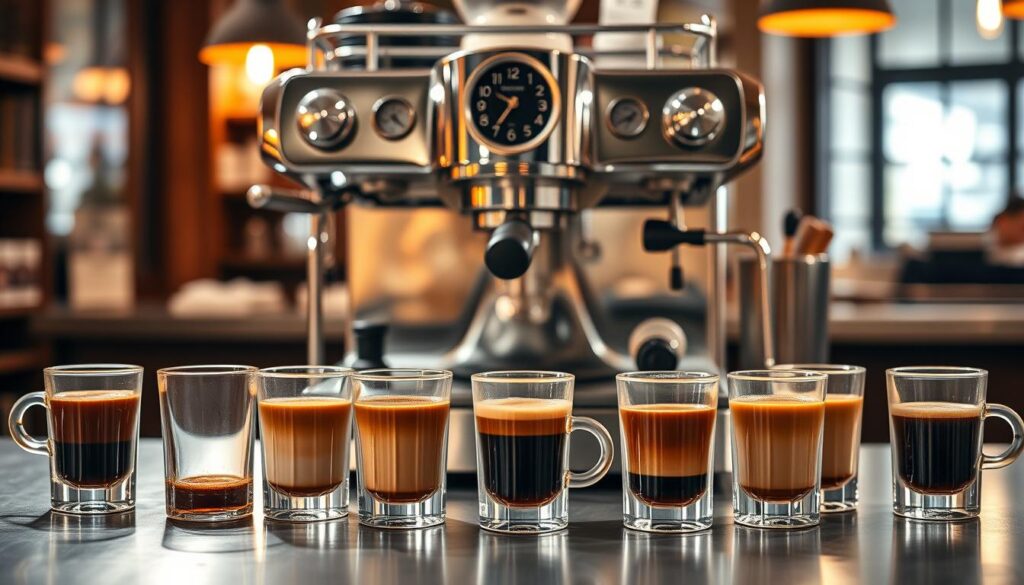
Your Brewing Method and Its Influence
Choosing how you brew your coffee is key. Knowing the difference between manual and automated espresso machines helps you pick the right coffee and brewing method. This choice affects your coffee experience.
Manual vs. Automated Espresso Machines
Manual espresso machines give you control over every step. You can adjust grind size, tamping pressure, and extraction time. This lets you try different brewing methods to find your perfect cup.
Automated espresso machines, on the other hand, make brewing easier. They have preset options for a quick coffee. But, you might not be able to tweak the brewing process as much.
Adjusting Coffee Types for Different Machines
The type of coffee you choose depends on your machine. With manual machines, you can explore a wide range of flavors. You can even try different roast levels to find new tastes.
For automated machines, picking the right coffee is key. Choose one that fits the machine’s preset settings. This ensures a great-tasting coffee every time.
| Feature | Manual Espresso Machines | Automated Espresso Machines |
|---|---|---|
| Control Over Brewing | High | Medium |
| Customization of Grind Size | Yes | No |
| Convenience | Low | High |
| Ideal for Experimentation | Yes | No |
| Consistency of Brew | Variable | Consistent |
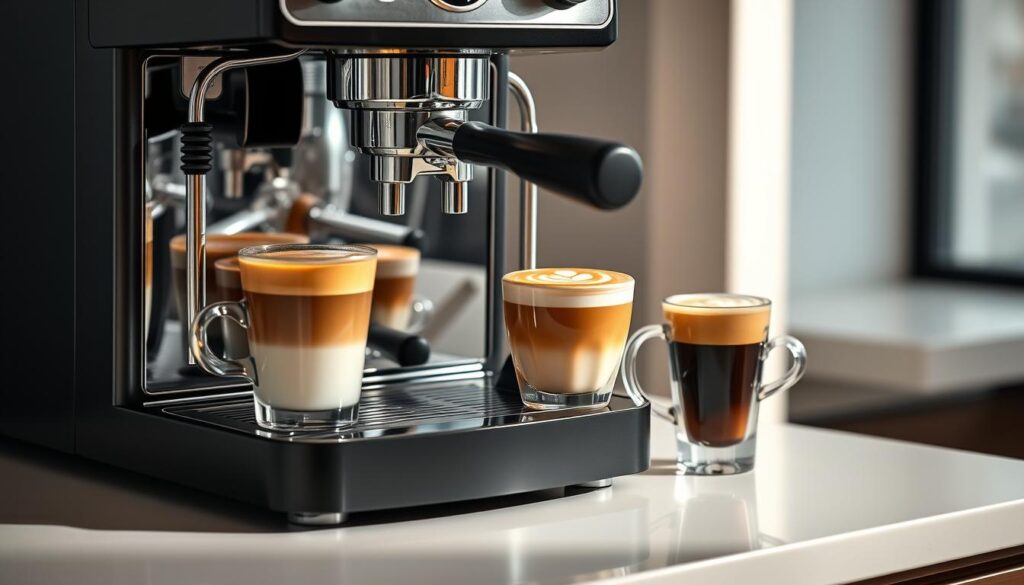
Experimenting with Your Coffee Choices
Using an espresso machine lets you try out different coffee blends. You can mix beans from various places or roasters. This way, you can make your espresso taste even better.
Each blend brings its own flavors and smells. You can find new favorites that make your taste buds happy.
Trying Different Blends
Don’t be afraid to mix beans with different tastes. For example, try mixing Ethiopian coffee’s bright taste with Brazilian beans’ chocolatey flavor. This can make a unique espresso blend.
Play with the mix ratios to make it just right for you. Keep track of what you try. This helps you find what you like best.
Sample Tasting and Feedback Techniques
Hosting coffee tastings with friends is a great idea. It’s a chance to share and learn about different espresso blends. Everyone can share their thoughts on the taste, smell, and feel of the coffee.
This feedback can improve your coffee-making skills. It also helps you find new blends you’ll love.

